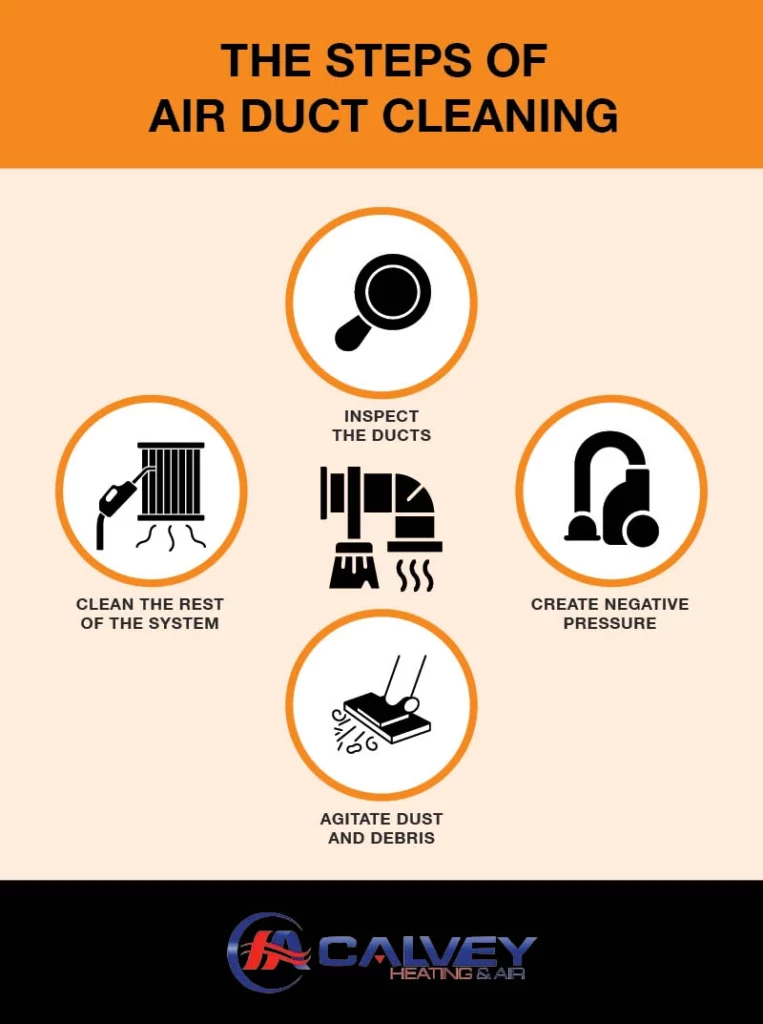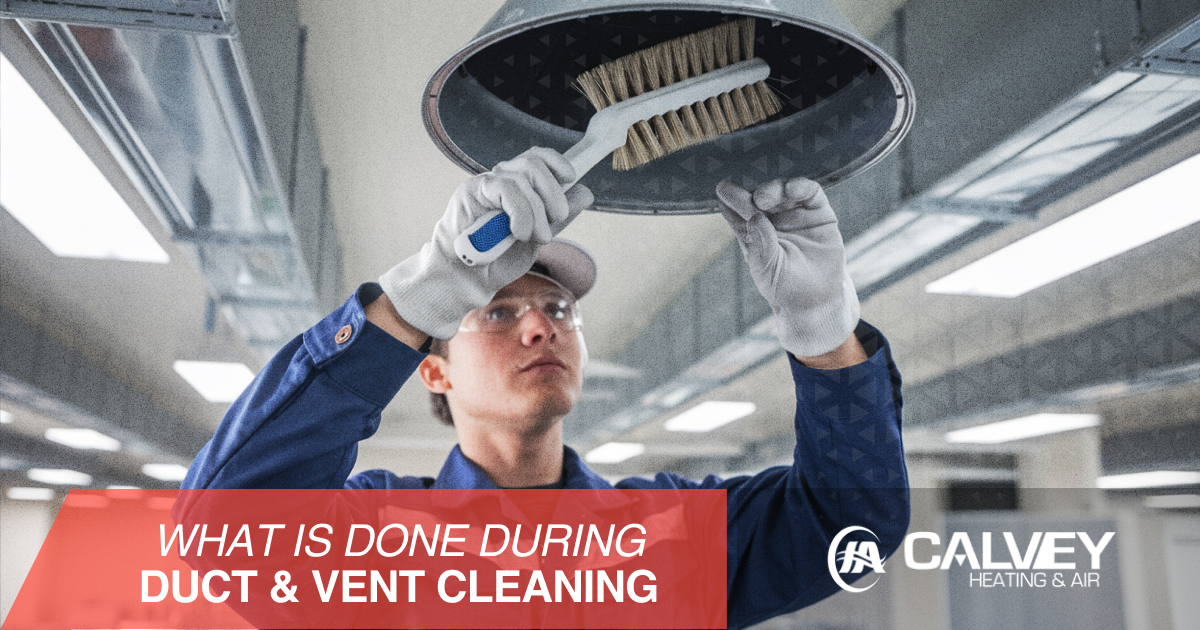If you’ve noticed that your home in San Jose, CA, or the Bay area is getting dustier than normal lately or your monthly electric bills are steadily increasing, dirty vents and air ducts could be to blame. Fortunately, a professional air duct cleaning process can help correct these problems and give you some relief. It’s important to hire a credible, skilled duct cleaning company like Calvey Heating and Air to clean your home’s ductwork, vents, and HVAC components.
Before you contact us for vent and air duct cleaning services, it’s important to know how the process works. Read on to learn more about ductwork cleaning, its benefits, and the steps involved in improving your home’s indoor air quality.

What Is the Air Duct Cleaning Process?
The process of air duct cleaning involves a method called negative pressure technology. This vital part of the duct cleaning procedure produces reliable, consistent results for cleaning the air ducts in your home. Reputable companies like ours are happy to teach homeowners about the National Air Duct Cleaning Association’s (NADCA) standard cleaning methods.
During the process, we’ll clean the air ducts and vents, registers, and filters. We clean virtually every part of your home’s forced-air HVAC system so you get noticeable results. The NADCA calls these procedures “source-removal techniques,” which include sweeping your air ducts by hand and using compressed air equipment. A special vacuum collection system removes all the dislodged dust and debris to keep your home clean before, during, and after the process.
The Steps of Air Duct Cleaning
HVAC duct and vent cleaning involves several steps. Here are the key steps involved in the air duct cleaning process.
Step one: Inspect the ducts
The first step involves performing a thorough visual inspection of the air ducts leading to the return and supply registers. This inspection helps the technician determine how much debris is in the ducts now versus how much they remove once the cleaning process is complete. The technician removes and cleans all the vents in your home before proceeding with the inspection.
Cameras are used to probe far into the ductwork, so the entire scope of the buildup is fully visible before cleaning begins. An inspection also helps the technician look for any leaks in rigid ducts or kinks in flexible ductwork. If there are issues, the technician will fix and restore damaged areas to help prevent problems with airflow and HVAC system functionality in the future.
Step two: Create a negative pressure
During this step, large portable or truck-mounted vacuum equipment is used to create negative pressure that sucks the dust and debris from your ductwork. Before this part of the process begins, the technician will attach a long hose from the vacuum collection equipment to an air duct located near the air handler, a component that is the heart of your home’s HVAC system.
Next, the technician cuts an access hole in the duct, inserts the vacuum hose, and seals the area as tightly as possible where the two areas intersect. Your HVAC system has a supply and a return side. Each of these sides represents ducts that deliver treated air into your home and ducts that return air to the air handler. The air duct cleaning process must be carried out on the return and supply side separately for the best results.
Step three: Agitate the dust and debris
The third step of cleaning the air duct is designed to help the technician expose and clean each register and all ducts individually while the machine is under negative pressure. Calvey Heating and Air uses the Rotobrush, a professional-grade tool that utilizes a spinning brush to loosen debris, dust, pet dander, dust mites, and other unpleasant contaminants from your air ducts.
Before using the Rotobrush, the technician applies a special adhesive cover to secure each register. This step is crucial because the vacuum collection system needs a tight seal for the suction to work properly. Once everything is sealed, the technician turns on the vacuum equipment to generate negative pressure. The collection system sucks particles inside the ductwork as they’re being brushed or blown loose.
Step four: Clean the rest of the system
Aside from cleaning the ductwork, the NADCA suggests cleaning other parts of your home’s HVAC system. This includes the air handler blower motor, evaporator coil, and drain pan. Thorough cleaning and cleaning or replacing the air filter helps to improve indoor air quality. It also extends the lifespan and improves the performance of your home’s HVAC system.
Benefits of HVAC Duct & Vent Cleaning
Duct and vent cleaning is an important part of good home maintenance. Here are some of the many benefits this service provides:
- According to the U.S. Environmental Protection Agency (EPA), indoor air pollutants are often two to five times higher than those outside. Regular duct and vent cleaning removes these harmful airborne particles, improving the air quality inside your home.
- Pests such as insects, birds, and small wildlife look for areas where they can safely nest, lay eggs, or give birth. Clean air ducts prevent these pests from choosing your place as their next home or breeding ground.
- Dirty air ducts promote mold and mildew growth, which harms your family’s health. Keeping your ducts clean ensures these contaminants don’t have an environment conducive growth.
- If you suffer from asthma, allergies, or other respiratory conditions, it’s important to keep your home’s air ducts clean so the air you breathe is free of harmful particles, dust, and other irritants.
- Clean air ducts help extend your HVAC system’s lifespan because it doesn’t need to work as hard to push warm or cool air throughout your home.
- Unpleasant things like pet dander, moisture, dust, and other airborne particles can accumulate inside your vents and air ducts. Over time, this creates a musty or unpleasant odor inside your home. Having your air ducts cleaned by our team of skilled technicians helps your entire home smell better and look and feel cleaner overall.
- Clean air ducts can help your HVAC system’s air filter last longer. Without so much debris pushing through the ducts, the filter remains cleaner for longer, saving you money.
- Lint and other materials gradually build up inside your air ducts over time, increasing the risk of a fire. This risk increases if you have an older HVAC system or one that uses gas or propane.
- Our skilled technicians are trained to look for other problems during your air duct cleaning. This allows them to identify any issues with your system earlier, helping you avoid more costly repairs later.
When Should You Schedule an Air Duct Cleaning?
It’s optimal to have your air ducts cleaned once per year as part of a regular HVAC system maintenance plan. However, the best time to schedule an air duct cleaning depends on a few factors.
Have your ducts cleaned in the fall or spring to help you prepare for the cold winter or the hot summer days in San Jose when temperatures typically climb into the 80s. It’s less likely that your system will run in spring or fall, making the duct cleaning process go smoothly.
Summer and winter are also great times of the year to schedule an air duct cleaning. Once the service is complete, you’ll enjoy an optimally running system that keeps your home cool in the summer and warm in the winter. You should also schedule an air duct cleaning if you notice the following:
- Visible signs of mold or mildew in your home
- A stale or generally unpleasant odor you can’t identify
- Sudden problems with pests
- Dust building up on furniture and other surfaces at a rapid rate
- Increased energy bills
Contact Calvey for Air Duct Cleaning Services
Contact the team at Calvey Heating and Air when you’re ready to schedule your next air duct cleaning service. Our online price quote system makes it easy to estimate your vent and duct cleaning costs before you make an appointment. Our detailed duct cleaning and dryer vent cleaning process helps give you an energy-efficient home no matter the season.


